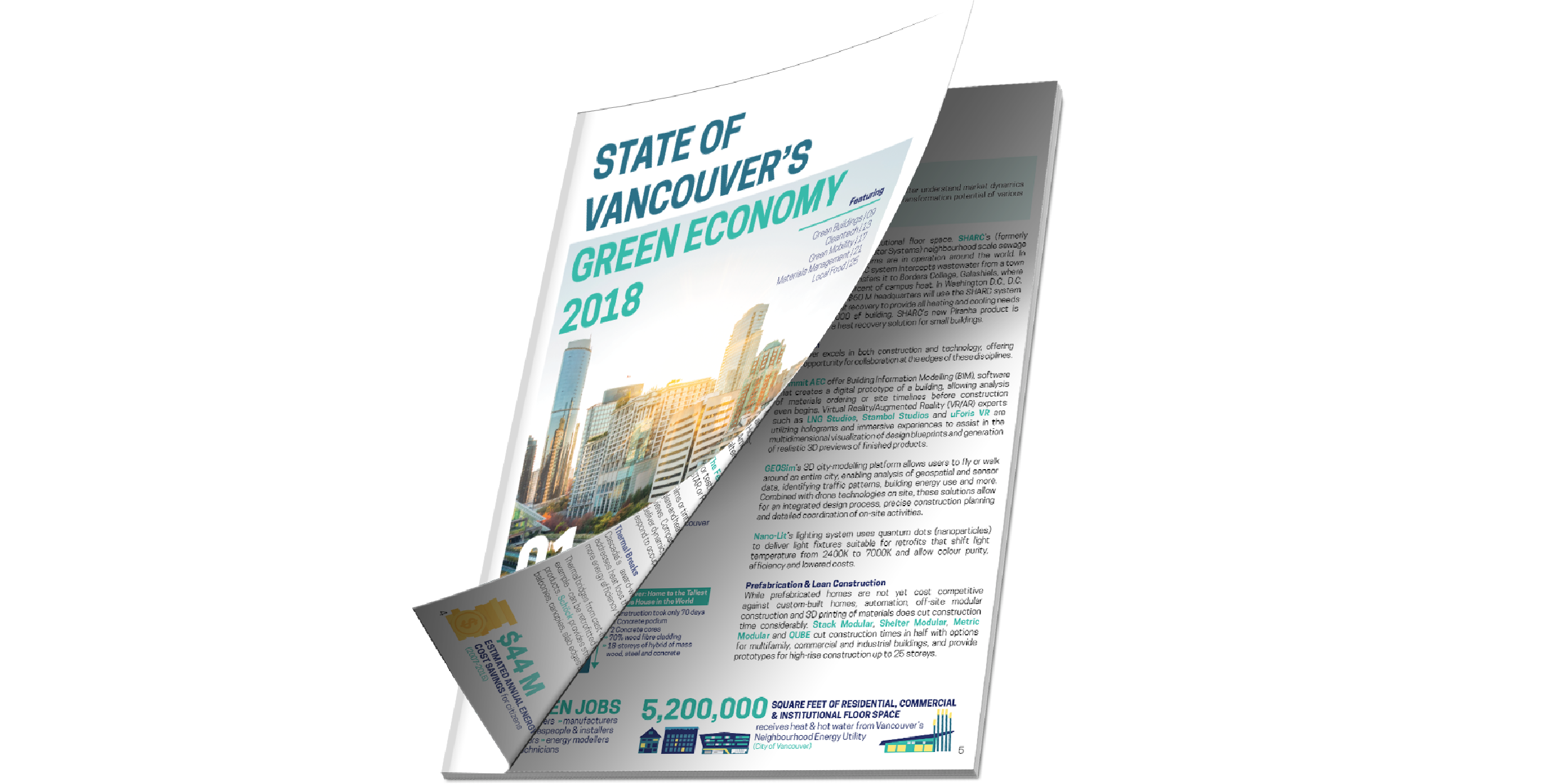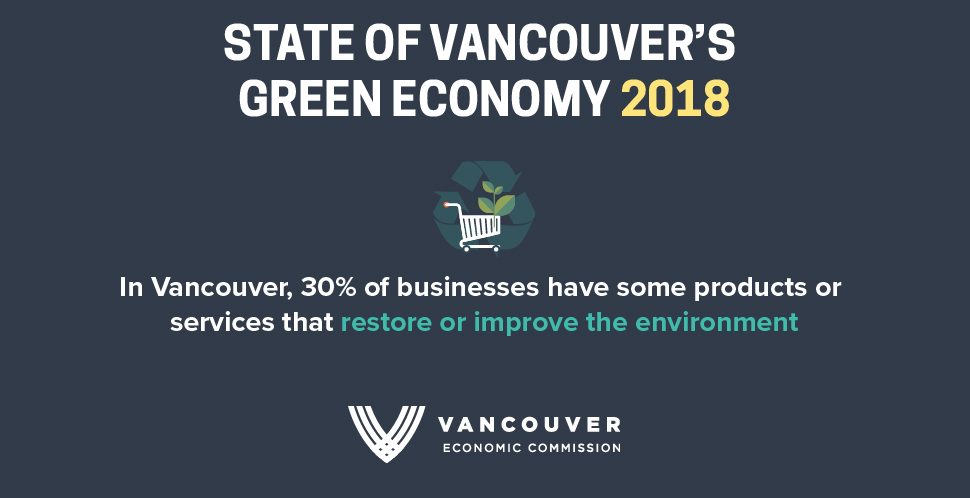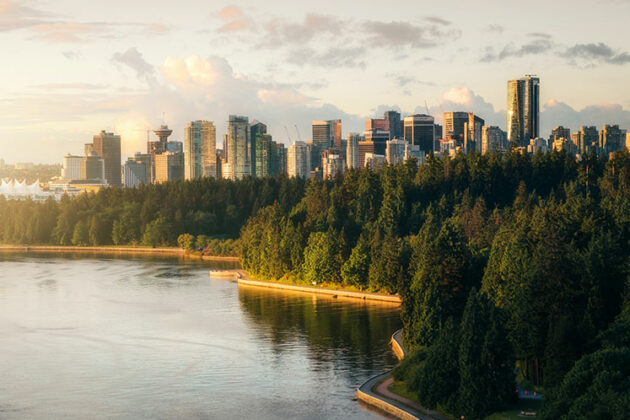Vancouver has long been a source for disruptive innovation in response to climate change – from the concept of the ecological footprint and the advent of the 100-mile diet, to being the birthplace of the fuel cell vehicle and prioritizing liveability over freeways in our downtown.
These innovations have been positive for the planet while stimulating our economy and delivering good green jobs. VEC began collecting green economy data in 2010 as part of a comprehensive Green Economy Strategy, a pillar of Vancouver’s 2020 Greenest City Action Plan. As we near the end of this plan, we have seen significant business transformation and this year we share our data and analysis in our State of Vancouver’s Green Economy 2018 report.
While we have achieved a great deal towards becoming one of the greenest cities in the world, we still have a lot of work to do. I invite you to read about our successes, and – more importantly – to join us in building this post-carbon world.
Here are some of the highlights from our research:
- Our analysis shows that Vancouver achieved a 30 percent reduction in the carbon intensity of our GDP. It means that as we go about our work and generate GDP, we do so while creating 30 percent less carbon emissions per dollar of GDP. It means we have become that much more efficient. It means that as we’ve had the fastest growing economy in Canada in recent years, we’ve also been building a low-carbon one. Some people refer to this as decoupling economic activity from carbon emissions, and we are proof that cities can do it.
- Our surveys found that 30 percent of Vancouver businesses deliver products or services that protect or restore the environment: Vancouver businesses have already recognized that this transition to a low carbon economy brings massive opportunity. Our businesses are already part of this transformation.
- Our data also shows a 35 percent increase in green employment since 2010. Today one in 15 Vancouverites works in the green economy, up from one in 20 just a few years ago.
And there is so much more data in the report, so please do download a copy.
But how did we get here? How did we get to this position today where Vancouver is recognized for a $31.5 billion brand, driven by clean and green leadership?
That story is also laid out in the report, but here is a bird’s eye view of the three key ingredients: policy, demand and innovation.
Policy Paves the Way
The City of Vancouver has set the bar very high in terms of policy leadership.
Not only do we live in a province where government has committed the entire public sector to be carbon neutral, and where we have a price on carbon, but in Vancouver we have also had the very clear framework of the Greenest City Action Plan since 2010, and new commitments to powered 100 percent by renewable energy, send absolutely no waste to landfill or incinerator and be a Zero Waste city, all by 2040.
These are world leading aspirations for a community, and the City of Vancouver has also led by example. We have the largest electric vehicle fleet of any municipality in Canada and we have plans to expand this further to include light and even heavy duty electric vehicles.
These policies have also driven the second key ingredient, which is demand.
Demand Drives Clean Growth
Policy creates a framework, but there would be no market without demand. In some cases, policy has also increased the pace of demand. For example, The City of Vancouver, University of British Columbia and others all have polices to purchase significant amounts of local food in their operations. This has helped to grow demand for B.C. food and agriculture.
But it’s not just governments driving demand for clean and green alternatives – take for example the fact that one-third of British Columbians want their next car to be an electric vehicle. This is what British Columbians want: a cleaner, greener, more resilient future. And that’s what people want around the world, too. The global market for clean technology is supposed to reach $1 trillion in the next few years.
And the final ingredient is innovation.
Innovation Breaks New Ground
Vancouver is recognized time and again for having an entrepreneurial mindset. We are a place of passionate people with ideas that are delivering game-changing technologies that are changing the world. We have companies like Carbon Engineering, General Fusion, Saltworks and Terramerra. Over 200 similar green leaders are profiled in our Green Economy report, all paving the way to a low-carbon economy.
All of this is detailed in our State of Vancouver’s Green Economy report. And don’t forget our invitation! Whether you live in Vancouver or in any other part of the world, come join us in this global transformation.
 Juvarya Veltkamp, Lead Writer
Juvarya Veltkamp, Lead Writer
Juvarya Veltkamp, Manager, Green Economy Initiatives, is a Green Economy practitioner, focused on progressive and sustainable approaches to economic development and business. With specific expertise in green buildings, clean technology and local food, Juvarya loves to create pragmatic solutions that address the triple bottom line of people, planet and profit.
Want to learn more about trends, leaders and innovative solutions in our sustainability ecosystem? The State of Vancouver’s Green Economy 2018 report features more than 200 leaders driving the transition to a low-carbon, resilient economy. Read the full report.




